A journey to Marrakech is an enchanting sensory odyssey where every step awakens your senses with a burst of exotic sights, captivating sounds, enticing scents, and delightful flavors. Often referred to as “the Paris of Morocco,” this city is also affectionately called the “Red City” or “Al Hamra.” At the heart of Marrakech lies Djemma El Fna Square, a vibrant epicenter offering a plethora of experiences. Here, you can explore beautifully vibrant souks, wander through lush gardens, visit opulent palaces, be entranced by snake charmers, savor delectable treats at open-air food stalls, and indulge in an array of shopping opportunities to uncover authentic Moroccan treasures.
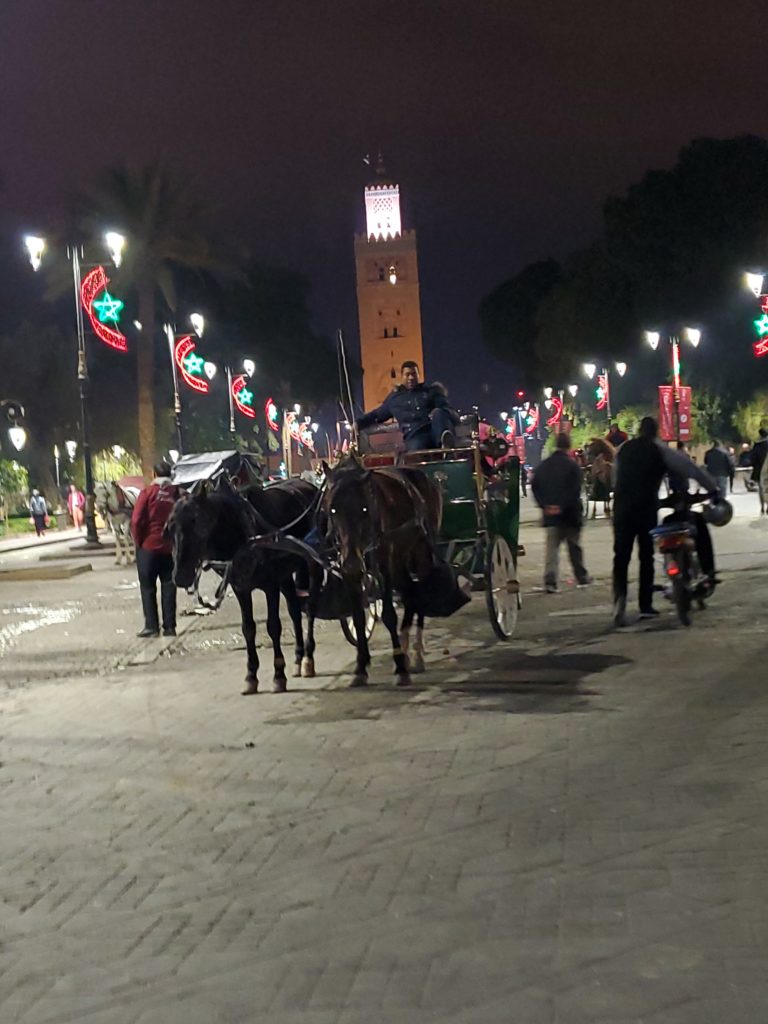
Horse and Carriage Ride, Marrakech – New York Jewish Travel Guide
Mr. Jacques Kadoch, the President of the Jewish Community of Marrakech, provided an insightful update on the state of Jewish life and the local community during a gathering of visiting journalists. Regarding the size of both the Marrakech and overall Moroccan Jewish communities, he mentioned that while the Marrakech community currently numbers less than 120 members, down from 138 the previous year, they have witnessed a significant influx of visitors from Israel in recent years. In fact, over the past five years, more than 80,000 visitors from Israel have arrived, and they anticipate the number to exceed 100,000. Mr. Kadoch highlighted that many of these visitors will undoubtedly pass through Marrakech, given its unique and vital significance.
Moreover, Mr. Kadoch shared encouraging news about a rise in celebratory events within the community. Over the last two years, there has been a consistent rate of at least three weddings per month, alongside the celebration of more than five bar mitzvahs, encompassing both Sephardic and Ashkenazi traditions. He emphasized the inclusive nature of their community, stating that everyone, regardless of their heritage, is warmly welcomed to celebrate their joyous occasions with them.
Mr. Kadoch also expressed his optimism regarding the ongoing discussions with local authorities to establish a new Jewish Center. This anticipated center holds the promise of significantly expanding the capacity to accommodate a larger influx of Jewish, Israeli, and international visitors, thereby boosting tourism in the region. Currently, the synagogue space is quite limited, accommodating only 115 to 126 congregants from the two existing synagogues, despite an average attendance of 300 to 400 visitors for services. Hence, the forthcoming center is poised to be a true blessing for the community, addressing this space constraint and facilitating a richer communal experience.
In addition to this, numerous cemeteries across the country are undergoing construction and renovation to create new synagogues.
This endeavor is anticipated to not only enhance visitor numbers but also specifically draw more pilgrims to Hillouloth. These pilgrimages are embarked upon by Moroccans from all corners of the globe, commemorating the anniversary of a revered rabbi’s passing.
These developments mark a positive and promising chapter in the revitalization of Jewish life and heritage in Morocco.
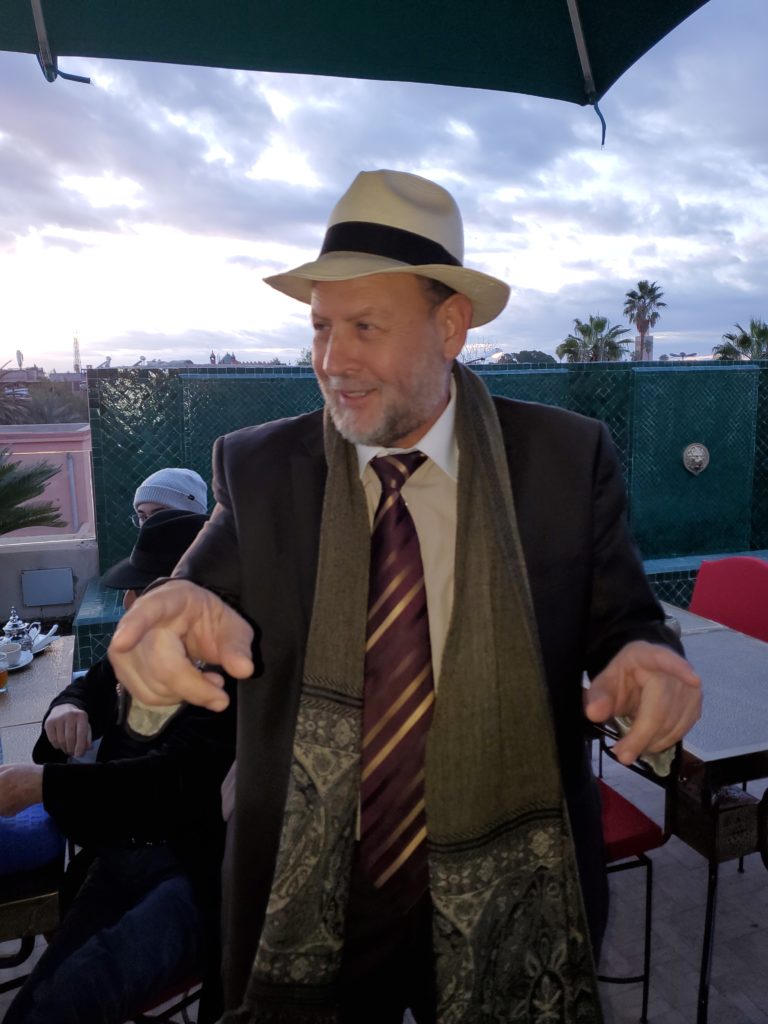
Mr. Jacques Kadoch, President of the Jewish Community of Marrakech—New York Jewish Travel Guide
Mr. Kadoch highlighted the growing interest among Moroccan students in learning about Moroccan Jewish history and mastering the Hebrew language. He proudly noted that there are now Muslims within the community who are fluent Hebrew speakers. Each year, thousands of Israeli visitors come to the region for holidays, although they are restricted to a 14-day stay according to the law. However, for those wishing to extend their stay, it is possible to obtain an extension through the court system.
Regarding his own future with the community, he expressed a commitment to serving as long as possible, citing his significant responsibilities to the community. However, on a personal level, he made a promise to his children and grandchildren to spend all their holidays with them in Israel. Throughout the year, his dedication remains unwavering as he continues to devote himself to his community and his partnership with Morocco. He also shared a piece of advice from Rabbi David Abuhasera in Nahariya, Israel, who affirmed that Mr. Kadoch’s place and responsibility are in Morocco, where the community needs him.
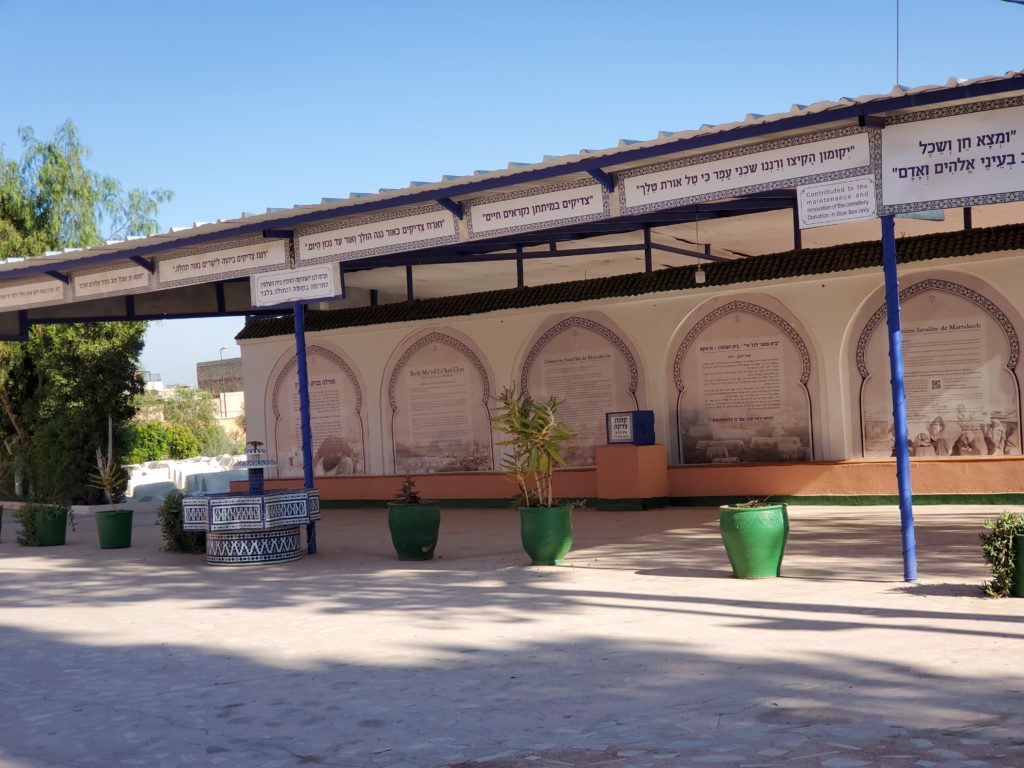
Miara Jewish Cemetery, Marrakesh: New York Jewish Travel Guide
Accessed through a wooden door adorned with a Hebrew sign, the cemetery offers designated areas for mourners, congregation halls, and separate burial sections for men, women, and children. Although the cemetery boasts a 600-year history, its tombstones showcase a rich diversity of styles. Some bear Hebrew inscriptions, while others are simple, unadorned stones, often featuring candleholders. Due to space limitations, the cemetery is organized into three layers of burial grounds, all crafted from stone.
Of note are the distinctive tombstones marking the final resting places of those who sought refuge in Morocco during the Spanish Inquisition, when a significant number of Sephardic Jews fled from Andalusia to escape persecution. These tombstones stand as poignant reminders of historical migrations and the enduring legacy of the Sephardic Jewish community in Morocco.
Just as they cherish their living heritage, the Marrakech Jewish community also shows profound care for their departed members. The Miara Jewish Cemetery in Marrakech, one of the largest cemeteries in Morocco, spanning 52 hectares, is nestled adjacent to the Jewish quarter of the city. This sacred site includes a small exhibition that recounts the histories of Marrakech’s Jewish community and provides insights into the restoration efforts undertaken. Notably, near the entrance, you can find the graves of Kohanim, Jews from the priestly class, marked in blue. In stark contrast, the other tombstones gleam in brilliant white against the intense Moroccan sun and the deep red walls.
This cemetery serves as the final resting place for more than 20,000 souls, with tombs dating back as far as the 14th century and continuing to the present day. The diligent upkeep of this cemetery is a shared responsibility of the Jewish community and the dedicated third-generation caretaker siblings, Khalid, and Otman Kanami.

Miara Jewish Cemetery, Marrakesh: New York Jewish Travel Guide
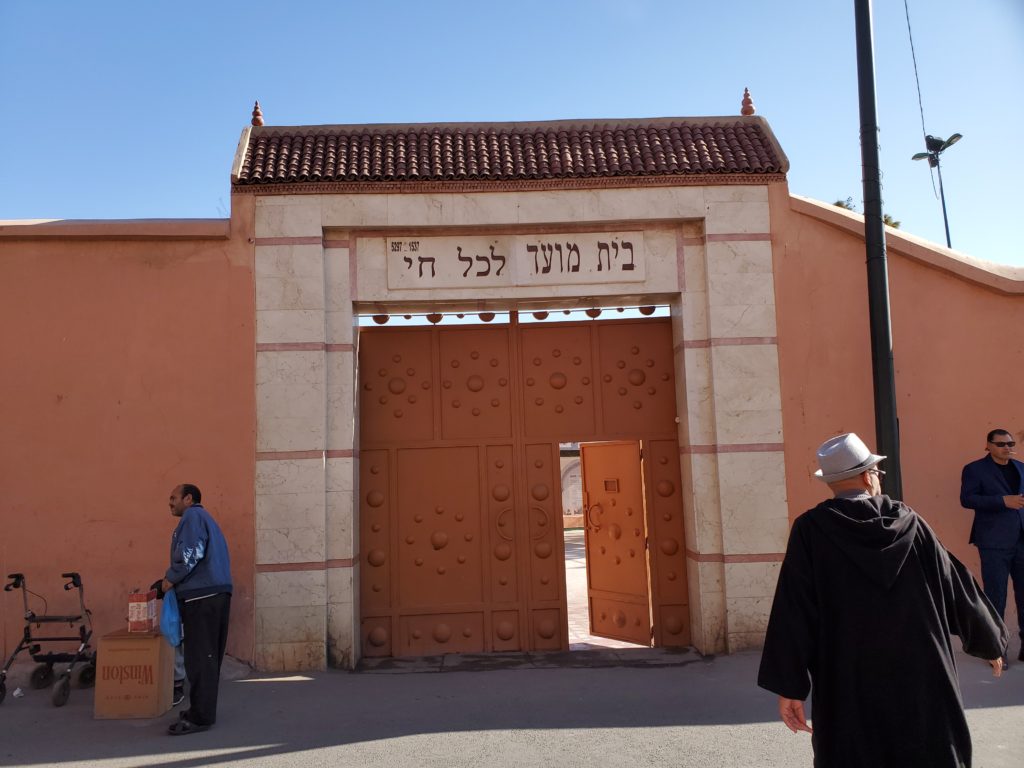
Entrance to the Miara Cemetery: A New York Jewish Travel Guide
One corner of the cemetery holds a solemn tribute to 6,000 children who tragically succumbed to a typhus epidemic. Along the outer perimeter, you’ll find 11 mausoleums serving as the final resting places for esteemed rabbis. Among these renowned Moroccan sages are Rabbis Hanania Hacohen and Isaak Delouya, the latter being a disciple of Joseph Caro. Annually, several Hilloula celebrations take place on the anniversary of these rabbis’ deaths, providing an opportunity for the community to pay their respects to a bygone era that was once an integral part of Moroccan culture and history.
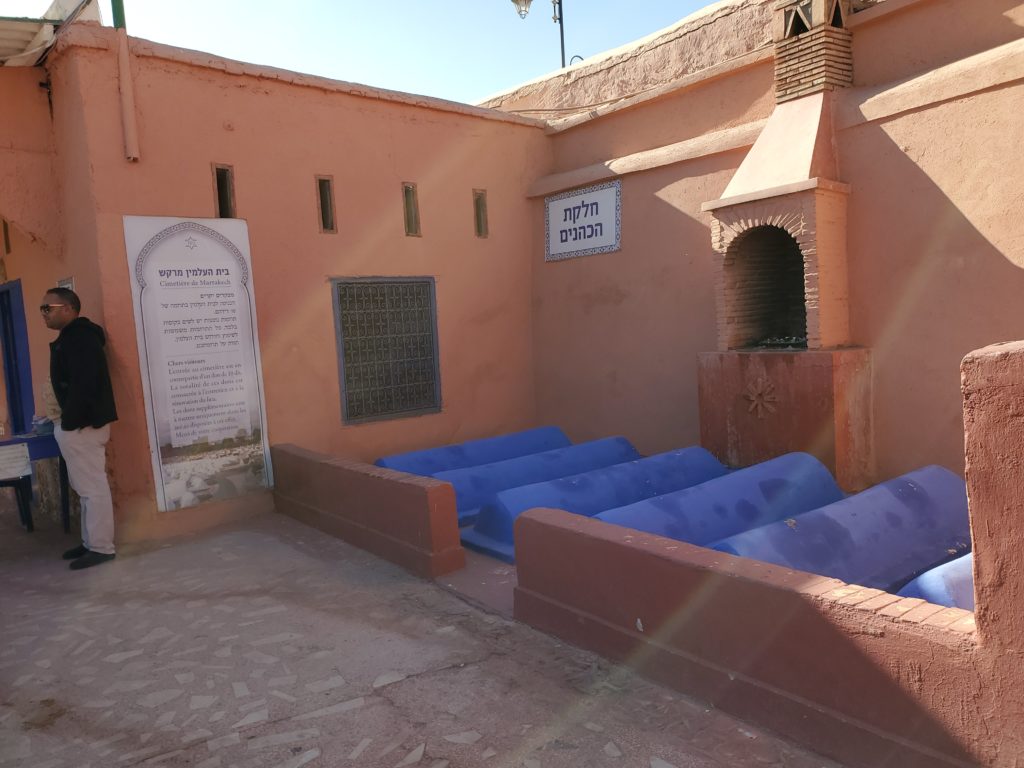
Miara Jewish Cemetery, Kohanim Section, Marrakesh—New York Jewish Travel Guide
Lazama Synagogue: A Hidden Jewel of Worship
In the heart of Marrakech, a city that now shelters just over 100 Jewish residents, including a few nestled in the historic Jewish quarter, stands one of the two remaining synagogues in the Mellah district. This petite and charming place of worship is known as the Lazama Synagogue, a name derived from “Al Azama,” signifying “those who escaped from Spain.” Its origins trace back to the year 1492, and it has been lovingly reconstructed over time.
The synagogue, nestled within the old Jewish Quarter, is a testament to the city’s rich history. It follows the traditional Moroccan riad architectural style, boasting a central courtyard adorned with a fruit tree and a few chairs, offering a welcoming spot for weary travelers. As you approach the entrance, a mezuzah adorns the doorframe, symbolizing the sanctity of the space. Inside, the walls are adorned with intricate patterns crafted from Zellige tiles, interspersed with the sacred Star of David, embodying the harmonious blend of Moroccan and Jewish cultural elements.
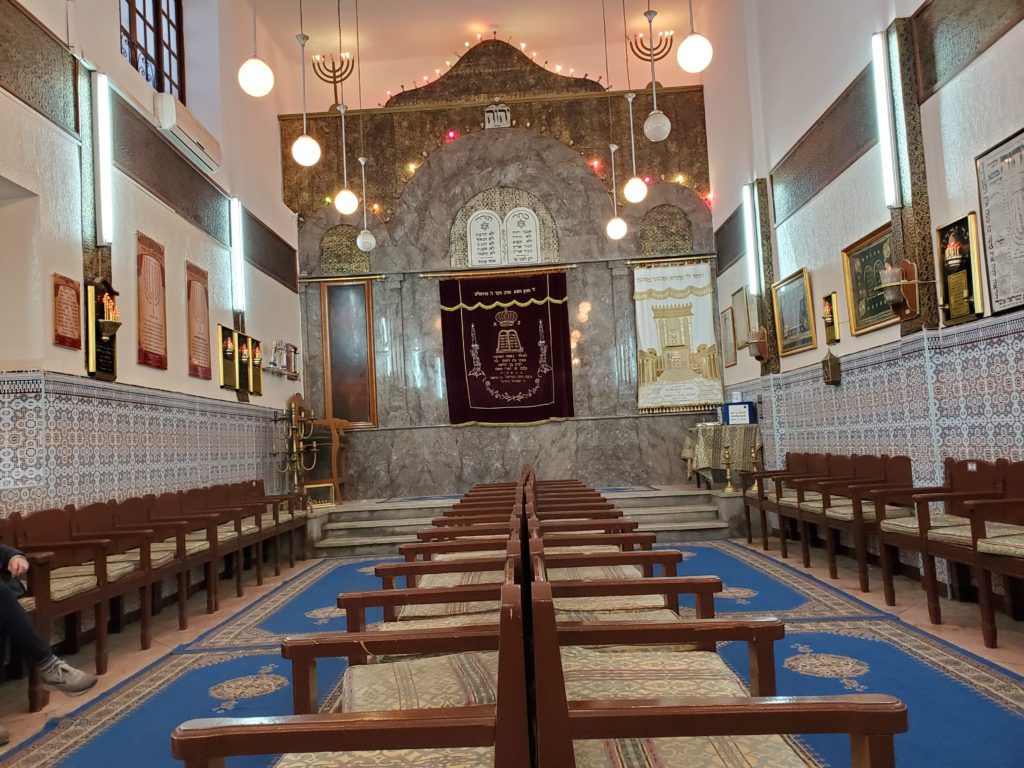
Lazama Synagogue, Marrakesh: A New York Jewish Travel Guide
The Lazama Synagogue houses a museum with several rooms surrounding its courtyard, each dedicated to a distinct facet of Moroccan Jewish history. Exhibits include the Jews of the Atlas Mountains, offering a glimpse into 2,000 years of Moroccan Jewish heritage through fading color photographs, documents, and videos. Other rooms showcase Jewish Moroccan music, a school with handwritten books, and a collection of old photographs documenting life in the Mellah.
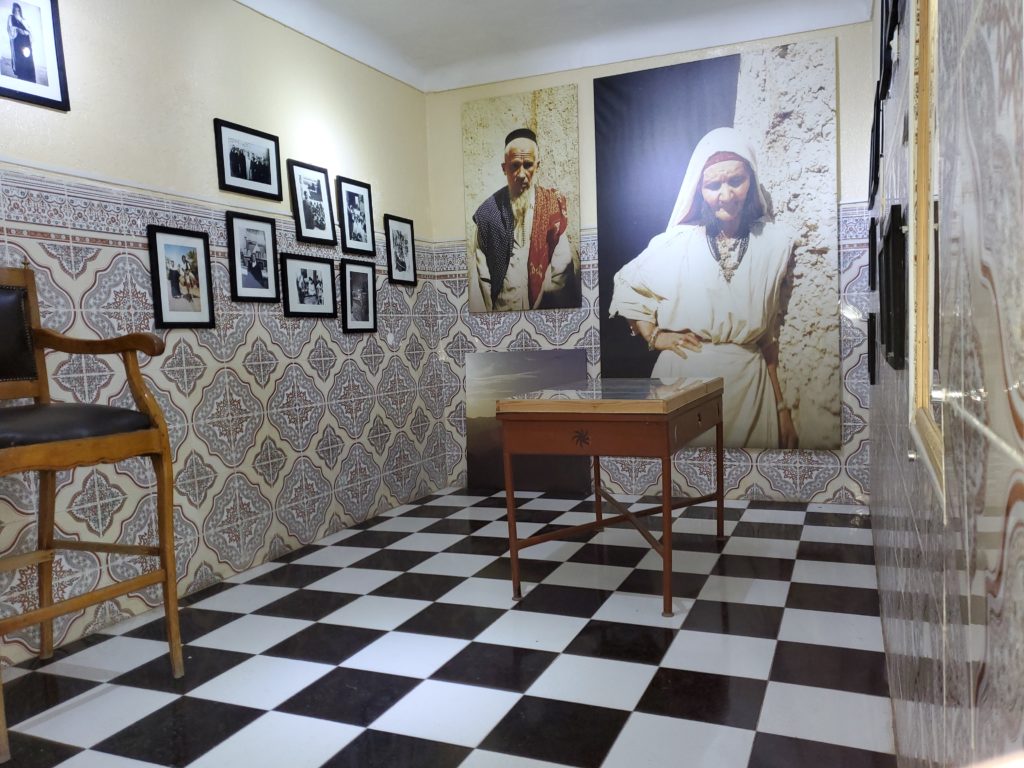
Room representing the Jews of the Atlas Mountains, essentially Berber Jews, at Marrakech’s Lazama Synagogue—New York Jewish Travel Guide
The Moroccan Culinary Arts Museum in Marrakech offers visitors a unique opportunity to learn how to prepare signature Moroccan dishes. By participating in workshops, you can leave with not only detailed recipe sheets but also a wealth of culinary inspiration to recreate these flavors at home. For more details, check out NYJTG’s interview with Ms. Chamae Ait-Ouahman, the sales agent of the museum.
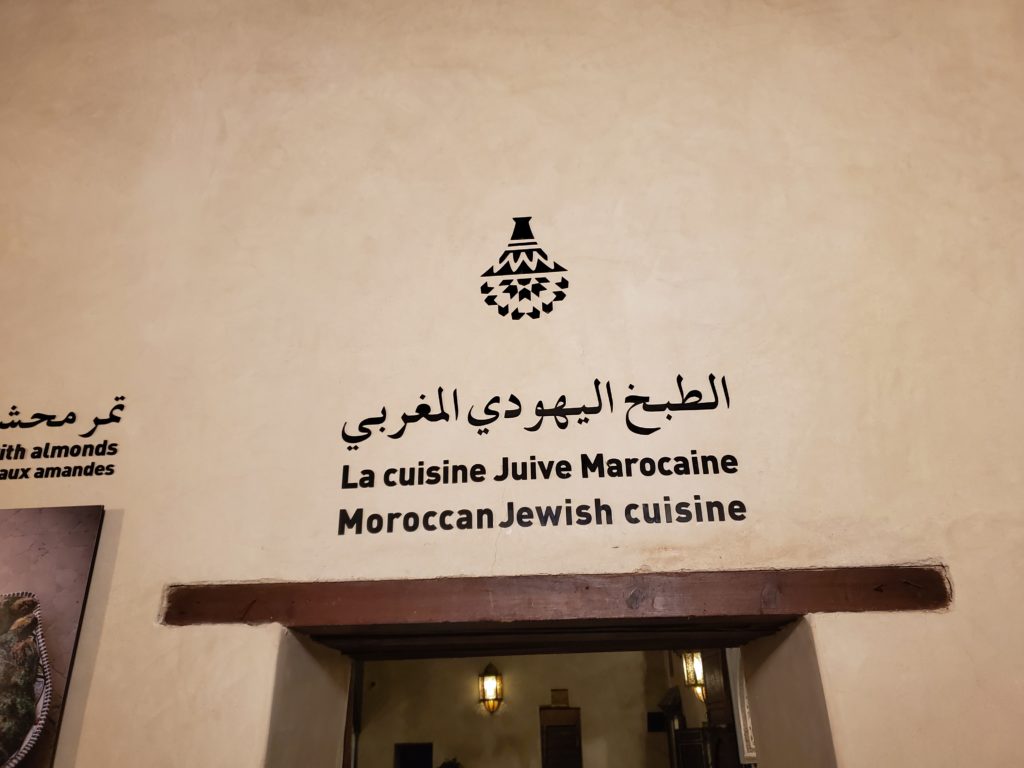
Moroccan Culinary Arts Museum, Marrakesh: New York Jewish Travel Guide
Exploring Fes’ Jewish Heritage
Fes, once Morocco’s capital and a spiritual hub, boasts the vast, car-free Fez Medina, a UNESCO World Heritage Site. Entering through the iconic Bab Boujeloud blue gate feels like a time warp of a thousand years.
Exploring the ancient Mellahs, or Jewish quarters, offers a captivating window into Morocco’s Jewish history. Despite their challenges, these quarters exude a unique and bustling charm, reflecting the vibrancy of Morocco’s Jewish heritage. A distinct feature is the Mellah’s larger windows and open balconies, in contrast to the more discreet windows in Muslim homes.

The Old Mellah, Fez – New York Jewish Travel Guide
The medina hosts the Slat al Fassayine Synagogue, the city’s oldest, and the discreet 17th-century Ibn Danan Synagogue, built by a wealthy merchant. The latter features a remarkable wooden bimah with an Islamic-style wrought iron canopy and an intriguing peephole into the ancient mikvah below. Nearby, the beautifully restored Jewish cemetery, Beit HaChaim, stands as the final resting place for numerous renowned rabbis, with rows of white-arched tombstones, some with candle chambers, gracefully adorning a gentle slope.
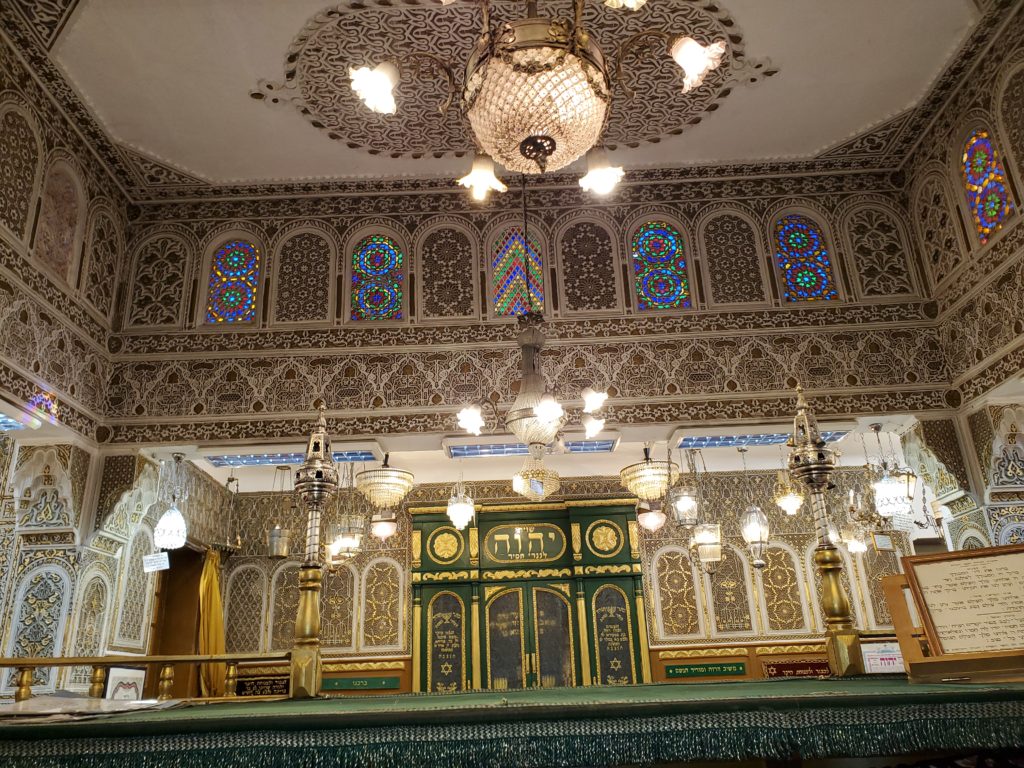
The Bensadoun Synagogue, Fes: A New York Jewish Travel Guide
The Bensadoun Synagogue, a testament to Fes’ enduring Jewish heritage, is a meticulously restored 17th-century synagogue. Although small, it speaks volumes about the longstanding Jewish tradition in Fes. The Bensadoun Synagogue, which remains in active use and is exceptionally well preserved, owes its existence to the patronage of Mimoun Ben Sidan, a successful merchant originally from Ait Ishaq.
The synagogue’s entrance appears unassuming, resembling nearby house doors. Upon entering, you’ll find a brief flight of stairs leading into the synagogue’s spacious rectangular hall. The synagogue’s architecture combines sturdy masonry covered with plaster, and the space is softly illuminated by petite stained-glass windows set high in the walls. It holds the distinction of being the sole functioning synagogue in Fes today.
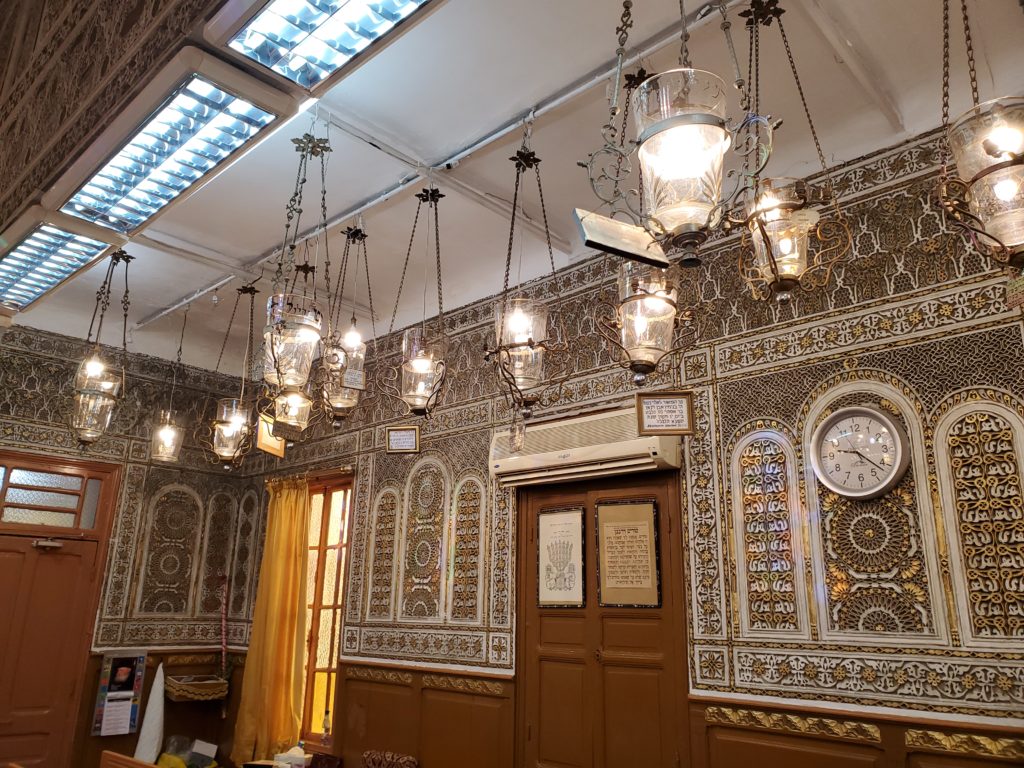
The Bensadoun Synagogue, Fes: New York Jewish Travel Guide
Adorning the synagogue’s interior are numerous memorial lamps suspended from the ceiling, creating a solemn ambiance. The walls are adorned with intricate wood paneling featuring blue-figured Moroccan tiles, adding to the synagogue’s visual allure.
At the heart of the sanctuary, a grand Torah Ark commands attention, spanning the width of an entire wall and crafted from intricately carved wood. Above it, the wall is embellished with exquisitely carved plasterwork.
Across from the ark, you’ll find a raised alcove, separated from the main prayer area by an ornate wooden screen, adorned with a series of arches. This alcove was designated as a seating area for the congregation’s esteemed members.
Dominating the space is a wooden bimah, crowned by an iron canopy fashioned with Islamic-style arches and intricate floral motifs, culminating in a majestic crown-like feature.
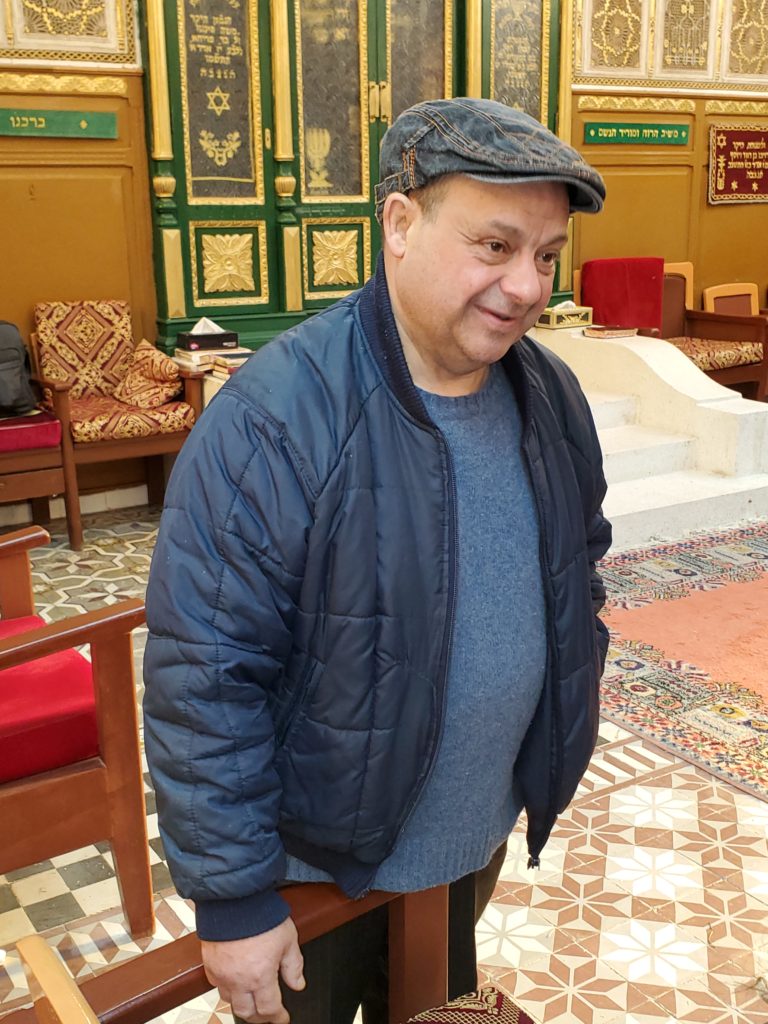
Mr. Shalom Tordgman, caretaker of the Bensadoun Synagogue, Fes: New York Jewish Travel Guide
Mr. Shalom Tordgman, aged 63 and a native of Sefrou, holds the important role of caretaker for the synagogue. Remarkably, he is the youngest member of the congregation. In a recent conversation with visiting journalists, Mr. Tordgman shared that approximately 40 Jews still reside in Fes, with only a handful attending regular weekly services, which fall short of forming a minyan. However, he highlighted that during the High Holidays and Hiloula, the synagogue draws visitors and tourists from around the world, often filling it to capacity.
The synagogue possesses nine Torah scrolls, each adorned with exquisite velvet coats embroidered in gold. A delicate white curtain separates the section reserved for women from the main prayer area. Rabbi Abraham Sebag serves as the official rabbi and a shochet, responsible for ritual slaughtering.
One remarkable aspect of this synagogue is its collection of original memorial lamps, acquired from former synagogues in the Mellah. These antique oil lamps retain their original nameplates, bearing a rich historical legacy.
Mr. Tordgman expressed his commitment to staying and caring for the synagogue, emphasizing that he has no plans to leave. Mr. Tordgman’s deep-rooted connection to this synagogue stems from his upbringing in the area, and his unwavering commitment is fueled by the warmth, love, and support he receives from the community. As he put it, “I have no family here, but I have a lot of people who love me here, and I want to ensure this synagogue is preserved for future generations.”
For more information, visit:
To plan a trip to Morocco, contact the Moroccan Tourist Office or go to http://www.visitmorocco.com/en.
Fly Royal Air Morocco: https://www.royalairmaroc.com/us-en/
Ride with Train Al Boraq, a high-speed rail service between Casablanca and Tangier.
(https://myticketservices.com/tgv-morocco-al-boraq-high-speed-train-e-tickets/)
Story and photography by Meyer Harroch, New York Jewish Travel Guide, and New York Jewish Guide.
The author took part in a press trip sponsored by the Moroccan National Tourist Office.



You must be logged in to post a comment Login